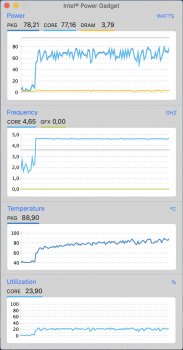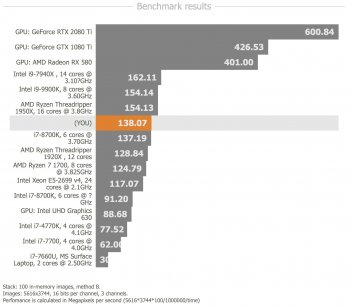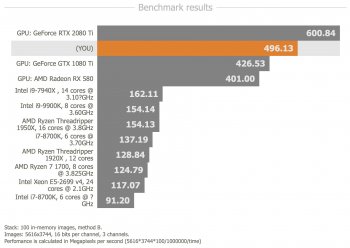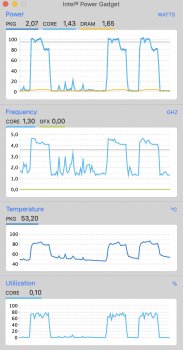Hi all,
I didn't really know where to post this, as it touches topics that were/are discussed in different threads, e.g. "580X Vs Vega 48 in the real world?", "Why people go for Vega 48?" or the various threads where people wonder if they should get the 2019 iMac with the i9 and/or Vega 48 graphics, but doesn't really fit into one or the other topic, so I decided to put it in a new thread. Sorry this post turned out to be a bit lengthy, I highlighted some parts to make it easier to jump to what might be interesting.
I got myself the i9 CPU with 40GB of RAM, 1 TB SSD and the Vega 48 graphics. I was coming from a 2011 17" MBP with i7@2.2GHz, a Radeon 6750M GPU, 16GB RAM, 1 TB EVO-850 SSD. Photo editing was mainly done in LR 6 until recently, when I switched to Capture One Pro.
So my new iMac had to be able to run Lightroom at "reasonable" speed inside a Parallels VM running El Capitan, and give me enough headroom to be happy working with it under Capture One (or whatever I'll be using in the future) for at least 8 years, that's why I went with the top config. And I wasn't disappointed.
Here are some tests I did and what I found:
(1a) Comparing LR speed on the 2011 MBP vs. a OSX 10.11 VM (4 cores, 8MB RAM, 512MB allocated for graphics) on the new iMac:
I used Lightroom to export a set of 119 24MP RAW images, all with adjustments and resized to 2MP. My MBP did this in 7:41, while the iMac needed 4:12 - that's 55% of the time, running inside a VM. Sweet!
Some other aspects I find noteworthy:
LR finished the export in 2:38 with GPU enabled and 2:33 CPU only. This is 3 times faster on the 2019 iMac vs. the 2011 MBP, with the benefit of GPU processing being negligible, and 1.6 times faster than the VM.
However, when doing the test CPU-only, the fans ramped up slightly after approx. 2:10 to a level where I could clearly hear them, but not to an annoying extent. They went back to base level right after the export was done.
NB: Lightroom 6.14 can still be installed and is running fine under 10.14.5, as the application is 64bit. However, the installer is a 32bit application, so might cause problems in future OS versions, that's when being able to run LR in the VM might come in handy.
(2) Comparing Capture One speed (2011 i7@2.2GHz vs 2019 i9@3.6GHz):
Here, I performed an export of 128 24MP RAWs with adjustments (most photos with 2-3 layers) and resizing.
2011 MBP (CPU only): 8:59
iMac (CPU only): 3:02
iMac (GPU enabled): 2:36 (roughly 3.5 times faster than the MBP)
Things I noticed:
Now I realize that someone coming from a newer machine will not find these performance gains that spectacular, but as we saw in that other thread many people use their Macs for a long time, so I hope this might be interesting to some who are still deciding on which machine to get. Long story short, I think the i9/Vega iMac is an amazing machine, I am not regretting spending the extra €€€ on CPU and GPU and hope this iMac will really last me a long time before wanting anything else.
EDIT: I added "mostly" to the thread title, because drawing masks in Capture One still is very far from a smooth, satisfying experience, see my post below.
EDIT #2: The lag when drawing masks seems to be a thing someone working on a 5K screen has to live with in 2019-see my conclusion below, with workarounds to make the lag bearable.
I didn't really know where to post this, as it touches topics that were/are discussed in different threads, e.g. "580X Vs Vega 48 in the real world?", "Why people go for Vega 48?" or the various threads where people wonder if they should get the 2019 iMac with the i9 and/or Vega 48 graphics, but doesn't really fit into one or the other topic, so I decided to put it in a new thread. Sorry this post turned out to be a bit lengthy, I highlighted some parts to make it easier to jump to what might be interesting.
I got myself the i9 CPU with 40GB of RAM, 1 TB SSD and the Vega 48 graphics. I was coming from a 2011 17" MBP with i7@2.2GHz, a Radeon 6750M GPU, 16GB RAM, 1 TB EVO-850 SSD. Photo editing was mainly done in LR 6 until recently, when I switched to Capture One Pro.
So my new iMac had to be able to run Lightroom at "reasonable" speed inside a Parallels VM running El Capitan, and give me enough headroom to be happy working with it under Capture One (or whatever I'll be using in the future) for at least 8 years, that's why I went with the top config. And I wasn't disappointed.
Here are some tests I did and what I found:
(1a) Comparing LR speed on the 2011 MBP vs. a OSX 10.11 VM (4 cores, 8MB RAM, 512MB allocated for graphics) on the new iMac:
I used Lightroom to export a set of 119 24MP RAW images, all with adjustments and resized to 2MP. My MBP did this in 7:41, while the iMac needed 4:12 - that's 55% of the time, running inside a VM. Sweet!
Some other aspects I find noteworthy:
- I attached a screenshot of Intel Power Gadget. You can see that during rendering, the VM used approx. 25% of the cores (sure, I set the VM to use 4 cores)-and because of this, the CPU ran around a constant 4,6GHz. Nice!
- CPU temperature slowly rose to approx. 90°C, but the fans didn't ramp up. Maybe during longer renders they will, but for this typical use case of exporting ca. 100 RAWs, that's really ok I think. I hear the fan constantly BTW, but it doesn't bother me too much, noise level reminds me of a spinning hard drive. Noticeable when it's quiet, but during the day time with some street noise coming through the window, I don't really hear it.
- OTOH, the fans on the 2011 MBP came on after 40 seconds, so noise-wise that machine was louder than the iMac during the process.
- Due to the iMac screen being so huge, I can run El Capitan inside a window that has the size of my 17" MBP's screen, while enjoying faster CPU speed and retina resolution. This is absolutely stunning to me. (The only drawback is that animations in the Finder, especially the dock, are really slow and choppy in the VM, although I allocated 512MB of RAM to it, which is recommended by Parallels. If there is a solution to this, please point me to it-thx!)
LR finished the export in 2:38 with GPU enabled and 2:33 CPU only. This is 3 times faster on the 2019 iMac vs. the 2011 MBP, with the benefit of GPU processing being negligible, and 1.6 times faster than the VM.
However, when doing the test CPU-only, the fans ramped up slightly after approx. 2:10 to a level where I could clearly hear them, but not to an annoying extent. They went back to base level right after the export was done.
NB: Lightroom 6.14 can still be installed and is running fine under 10.14.5, as the application is 64bit. However, the installer is a 32bit application, so might cause problems in future OS versions, that's when being able to run LR in the VM might come in handy.
(2) Comparing Capture One speed (2011 i7@2.2GHz vs 2019 i9@3.6GHz):
Here, I performed an export of 128 24MP RAWs with adjustments (most photos with 2-3 layers) and resizing.
2011 MBP (CPU only): 8:59
iMac (CPU only): 3:02
iMac (GPU enabled): 2:36 (roughly 3.5 times faster than the MBP)
Things I noticed:
- When enabling the GPU, Capture One will use nearly ONLY the GPU for the export. Using Intel Power Gadget, I observed an average CPU usage of 6% (at 2.5GHz) during the export, the temperature staying around 55°C. I don't have iStat menu so I don't know the GPU temperature, but fans stayed nicely at their base speed during the whole process. This is on the iMac-on the MBP, enabling the GPU makes the export process slower than when choosing "CPU only", that's why there is only one time for the MBP above.
- When disabling the GPU on the iMac, CPU speed stayed around 4.2GHz over the process, all cores used, with temperature rising to around 90°C. Here I heard the fans SLIGHTLY ramp up at one point during the export, but not annoyingly so.
Now I realize that someone coming from a newer machine will not find these performance gains that spectacular, but as we saw in that other thread many people use their Macs for a long time, so I hope this might be interesting to some who are still deciding on which machine to get. Long story short, I think the i9/Vega iMac is an amazing machine, I am not regretting spending the extra €€€ on CPU and GPU and hope this iMac will really last me a long time before wanting anything else.
EDIT: I added "mostly" to the thread title, because drawing masks in Capture One still is very far from a smooth, satisfying experience, see my post below.
EDIT #2: The lag when drawing masks seems to be a thing someone working on a 5K screen has to live with in 2019-see my conclusion below, with workarounds to make the lag bearable.
Attachments
Last edited:





